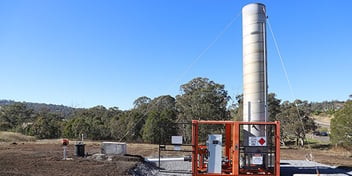Turning waste into resources through anaerobic co-digestion
There is much discussion in Queensland about the desire to move towards a circular economy, recover resources from waste and create new opportunities. A number of actions have or are about to commence, including a ban on single-use plastic bags, a container recovery scheme and a waste levy that commenced on 1 July this year.
While these might be considered recent developments, there have been people and organisations striving to stimulate and achieve resource recovery opportunities at scale for a long time.
The sold out Waste to Resource Australian Water Association Queensland technical meeting held at Aurecon’s Brisbane office in July brought together water industry professionals for an engaging seminar on this topic.
Attendees heard from the Director of Bio-futures Queensland Michael Burke about how the state has provided a valuable framework to enable resource recovery, and from Utilitas CEO Fiona Waterhouse, an entrepreneur with a first-hand commercial approach to resource recovery.
Engineer Mike Meng from Queensland Urban Utilities also addressed the audience. Below, Meng shares his experience in anaerobic co-digestion and working on new co-digestion strategies for large utilities.
Currently in the Queensland water industry, there is strong and emerging interest in waste to resources through anaerobic co-digestion (AcoD), which redirects organic wastes away from landfill for beneficial reuse.
AcoD is a biochemical engineering approach that simultaneously treats two or more waste streams in a centralised digestion facility for enhanced energy recovery and enables circular economy outcomes.
AcoD provides shared economic, environmental and social values. For co-digestion at sewage treatment plants (STPs) with existing digestion infrastructure, the enhanced biogas production from co-digestion processes typically means energy cost savings, as well as generating gate fees for water organisations.
With environmental enablers such as the Queensland landfill levy, AcoD is becoming increasingly attractive to leverage existing digestion infrastructure capacity and reduce organic waste disposal to landfill. Incorporating co-digestion as a waste-to-resource strategy also provides value to the broader community and shareholders, and enables cross-industry collaboration through strategic waste management partnerships.
While the benefits of AcoD are clear, effective co-digestion implementation requires a good understanding of digestion biology and co-digestion substrate impacts on the baseline digestion process. Therefore, a holistic management approach is recommended, with four key areas: substrate property management, co-digestion mixture design, co-digestion operation control, and associated downstream impact management.
Understanding the physical, chemical and biological properties of co-digestion substrates is an important first step to avoid incompatibility of co-digestion mixtures. Typically, Biomethane Potential (BMP) testing and associated mathematical modelling are useful tools to characterise potential co-digestion substrates, fractionating the wastes into biodegradable and non-biodegradable fractions.
Co-digestion mixture design is currently a big technical knowledge gap. Most organic wastes can be characterised by macro-compositions mixed in different ratios of carbohydrates, protein and lipids. These macro-compositions degrade at different metabolic rates via different biological pathways with different energy recovery potential. Therefore, a strategic co-digestion mixture design is necessary to avoid ad hoc waste loading into the digesters and provides a more advanced approach for operation than relying on empirical carbon-to-nitrogen (C/N) ratios.
Operational control of co-digestion processes needs to ensure that the designed co-digestion mixtures are optimally destructed in a digester and effectively converted to biogas production for beneficial reuse. Otherwise, substrate washout may occur from the process, resulting in negative downstream biosolids and nutrient impacts.
In many cases, the feasibility of co-digestion projects is a trade-off between the biogas values and co-digestion downstream impacts. Due to the nature of biology and digester efficiency, co-digestion processes can result in additional mass of biosolids and nutrients for treatment. Effective management of these impacts often requires non-conventional technologies for an economically viable solution.
With increasing emphasis on the social and environmental values of waste to resources it is anticipated that co-digestion will be integrated more extensively into sustainable water management strategies and open up various resource recovery opportunities from co-digestion products.
AWA Queensland holds technical meetings every month with varied and interesting topics for all disciplines in the water industry. We hope to see you at the next event! To find out more, click here.


